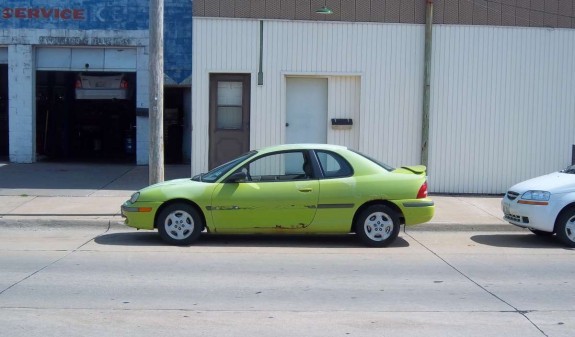The 1990s were a transformative era for Chrysler, marked by a resurgence of innovation and exciting new models. Among these standouts, the 1995 Neon Dodge emerged as a vibrant contender in the subcompact car segment. This spunky little vehicle aimed to inject some much-needed American flair into a market often dominated by Japanese automakers, promising a blend of style, space, and driving fun.
A Welcoming “Hi” and a Fresh Design
Capitalizing on the momentum of the acclaimed LH sedans, Chrysler launched the Neon with a memorable “Hi” advertising campaign, instantly grabbing attention. Debuting as an early 1995 model, the Neon, available as both Dodge and Plymouth variants, was designed to be a breath of fresh air compared to its predecessors like the Dodge Shadow and Plymouth Sundance. These older models, with their boxier, late-80s aesthetics and K-car origins, were starting to feel dated. The Neon, in contrast, boasted a contemporary, almost European design sensibility that made it stand out. Its rounded contours and cheerful front fascia, as Dodge’s 1995 brochure eloquently put it, were designed to “put a smile on your face every time you look at Neon’s face.” This fresh look, coupled with an attractive price point, positioned the 1995 Neon Dodge as a serious challenger to the established players, particularly the Honda Civic. There was a genuine hope that the Neon could be America’s answer to the Japanese subcompact invasion.
Trim Levels and Performance: Something for Everyone
The 1995 Neon Dodge was offered in both four-door sedan and two-door coupe body styles, catering to a range of needs and preferences. Trim levels started with the budget-friendly Base model, easily identifiable by its black bumpers, and progressed to the slightly more upscale Highline version. Regardless of trim, both models came equipped with a spirited 2.0-liter, SOHC 16-valve inline four-cylinder engine. This powerplant delivered a respectable 132 horsepower and 129 lb-ft of torque, figures that were considered class-leading at the time, offering a peppy and engaging driving experience for a subcompact car. Standard features like dual airbags, uncommon in this segment then, further enhanced its appeal.
Unleashing the Sport Coupe and ACR Models
Expanding on the Neon’s sporty potential, Dodge soon introduced the Sport Coupe variant of the 1995 Neon. This wasn’t just a two-door version; it packed an extra punch. The Sport Coupe boasted a DOHC version of the 2.0-liter engine, boosting output to an impressive 150 horsepower and 133 lb-ft of torque. Coupled with its lightweight construction (around 2,384 lbs), the Neon Sport Coupe offered a genuinely fun and agile driving experience. For those seeking even more performance, the legendary Neon ACR (American Club Racer) Sport Coupe emerged. This special edition, geared towards autocross and track enthusiasts, took the Neon’s sporting credentials to another level.
The Neon ACR, available with either the SOHC or DOHC engine, featured performance upgrades like four-wheel disc brakes, Arvin non-adjustable struts, enhanced anti-sway bars, a close-ratio five-speed manual transmission, and a higher final drive ratio. These modifications transformed the already nimble Neon into a surprisingly capable track car, able to challenge much more expensive vehicles on a road course. Even today, the Neon ACR remains a beloved choice for budget-minded track day enthusiasts.
Reliability Hiccups and Quality Concerns
Despite its many positive attributes, the 1995 Neon Dodge was not without its drawbacks. One of the most significant issues was the notorious head gasket failures, often occurring around the 60,000-mile mark. While the repair is relatively inexpensive today, it was a major frustration for original owners. Furthermore, the Neon’s overall build quality and fit and finish were not on par with the increasingly high standards set by Japanese manufacturers like Toyota during the 1990s. This period saw Japanese automakers pushing the boundaries of quality, and in this aspect, the Neon fell somewhat short.
Distinctive Style and a Pop of Color
Beyond its performance and design, the 1995 Neon Dodge also distinguished itself with its vibrant color palette and interior styling. The “confetti” multi-color upholstery option added a playful and bright touch to the cabin, reflecting the energetic spirit of Chrysler in the 90s. Exterior color choices were equally bold, with options like the striking Nitro Yellow-Green. These adventurous colors, while not always mainstream hits at the time, have become increasingly sought after by collectors and enthusiasts today, mirroring the renewed appreciation for the High Impact colors of classic Mopar muscle cars. Spotting a Nitro Yellow Green Neon coupe now is a rare and memorable experience.
The Neon’s Enduring, Though Limited, Legacy
The first-generation Neon coupe was discontinued after the 1999 model year, and the Plymouth Neon brand itself disappeared after 2001. The Dodge Neon continued until 2005 before being replaced by the Caliber. Ultimately, the Neon did not achieve its ambitious goal of significantly impacting the Japanese dominance in the subcompact market. However, it remains a fondly remembered vehicle for its spirited driving dynamics, distinctive styling, and the burst of energy it brought to the American automotive landscape in the mid-1990s. While the Neon’s long-term impact on the industry might be debatable, its ACR variant cemented its place in the hearts of driving enthusiasts, and the hope lingers that future Dodge compact cars might recapture some of that original Neon magic.
[
